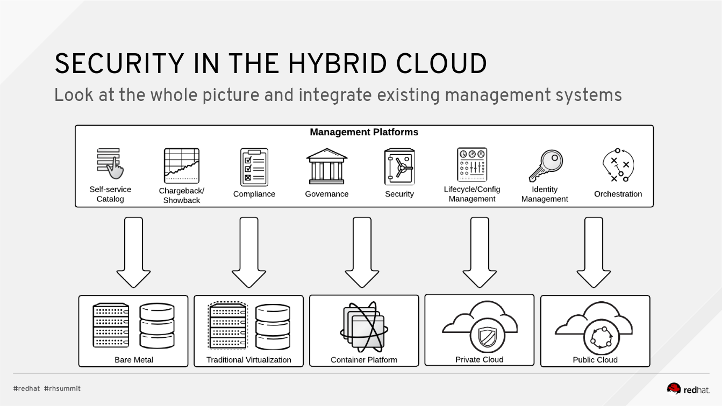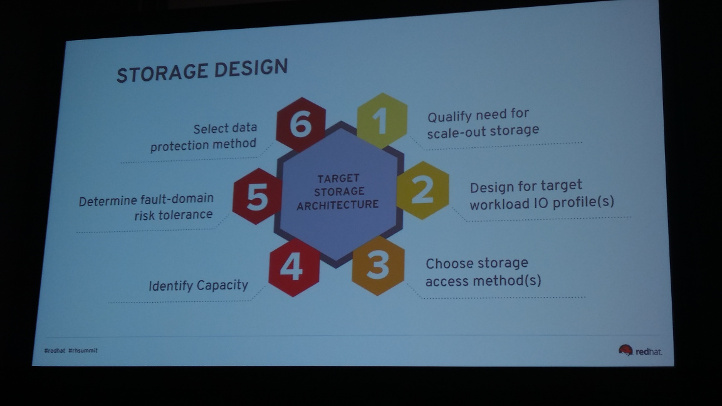In Wednesday’s keynote, CEO Jim Whitehurst stated, “How we organize to generate innovation matters”—that includes the people, technologies, and practices that make up your IT organization.
Traditional practices that worked in more stable business environments are being outpaced by a fast, unpredictable world. The future of IT then, according to Whitehurst, is about building IT that can handle whatever the future brings.
“Planning as we know it is dead.” - Jim Whitehurst
The core tenets of this future-ready IT replace strategic planning with a new vision: try, learn, and modify . . . and this vision extends to the cloud. The cloud you need today won’t be the cloud you’re running tomorrow—just like your business, it will be adapted to meet the market.
Today’s sessions gave insight on customizing the cloud to prepare for today’s—and tomorrow’s—business.
Customize hybrid cloud management with Ansible
Hybrid cloud not only combines key capabilities of both public and private clouds, but it can also serve as a gateway to pivot between legacy systems and newer, application programming interface (API)-based development. When creating a unique cloud services blend based on your specific business needs, you’ll also tune management of cloud and legacy environments to your specific development needs.
In their session, Ryan Brown, senior software engineer at Red Hat, and Tom Melendez, software engineer at Google Cloud Platform, shared how automating your cloud environments is key to:
- Keeping your IT professionals engaged.
- Handling projects more safely.
- Making the most of your resources and skills.
Ansible playbooks can be used to automate app and security update roll out, perform full tasks, and create roles for different tasks across teams. These roles are easier to adjust, helping you automate incrementally, starting with daily tasks then progressing to full roles.
Google, an active collaborator on Ansible, has created modules that make up playbooks for Google Cloud Platform.
“We’ve been using these modules internally for years. It’s exciting to get them out into the world.” --Tom Melendez

From Ryan Brown and Tom Melendez's presentation.
According to Brown, hybrid cloud also means determining if your vendors’ principles and goals align with yours. As you build your hybrid cloud, keep this need for united strategy in mind:
- Establish a plan for provider downtime, pricing, etc.
- Be conscious of costs related to transferring data-heavy apps.
- Keep in mind that splitting a workload is harder than running some workloads in each provider’s environment.
- Take advantage of automation by sharing it between clouds with Ansible playbooks.
Greater security according to hybrid configuration needs
Legacy IT doesn’t just disappear when you migrate to the cloud, even if it’s a complete single migration. The remaining risks of legacy IT—as well as the potential scale apps could reach—means designing greater security for an environment characterized by diversity.
According to Mike Bursell and Ted Brunell at Red Hat, some legacy management tools will still work in the cloud, or required too much investment to abandon, but management must address the needs of your entire environment—including the dynamic changes of cloud. The security tools you’ll need are also unique.

From Mike Bursell and Ted Brunell's presentation.
To establish hybrid cloud security practices, you’ll need to:
- Check that what you’ve implemented works according to your rules and policies—then you can automate to help reduce human errors and enforce the rules predictably.
- Clean up your data: Don’t keep old systems and workloads attached to your management services, even if they’re running OK.
- Find your balance of cost, security, and performance: Involve business teams so they understand and have a stake in the process.
“Legacy doesn’t just go away—be agile. Assume that you’re going to need to change.” - Mike Bursell, chief security architect, Red Hat
Jared Sanders, principal operations engineer at cyber defense company Tapestry Technology, shared how these practices are being used in the public sector to help provide military-grade security.
Choose the right storage for OpenStack clouds
Understanding your unique workloads and use cases is key to cloud storage, according to Red Hat’s Sadique Puthen, senior cloud success architect, and Rahul Vijayan, senior storage specialist solution architect.
“Getting your storage right is essential for your cloud. It may be at the bottom of your stack, but it shouldn’t be your last consideration.” - Rahul Vijayan.
There are six design considerations for storage architectures:

Slide from Sadique Puthen and Rahul Vijayan's presentation.
Part of designing your cloud storage includes understanding the needs of your workloads and apps, including:
- I/O size: Megabytes or terabytes?
- Protocol: What kind do you need: object, block, or file?
- I/O pattern: sequential or random?
- IOPS
- Capacity
- Throughput: Do you need high throughput? Tiering?
- Read—write ratios: Do you need more of 1 or the other?
Vijayan shared specific storage considerations for OpenStack® clouds. Together with compute and networking, storage is part of the foundation of OpenStack. Cloud can be public, private, or hybrid. Similarly, OpenStack storage can be based in physical or cloud resources or a hybrid of the two.
The composition of your OpenStack cloud storage, however, isn’t as important as its integration with OpenStack. The right solution should be tested and certified to help you save networking bandwidth, disk space, and time—and the right storage vendor should be able to give you a proof of concept showing how their solution integrates with your OpenStack cloud.
So the key to OpenStack storage in a nutshell? Find a solution that not only supports your current environment but can support your future storage needs.
[Today’s cloud sessions were all about customization, so insert your own cloud pun here]
From panels to sessions to customer stories, day two of Red Hat Summit brought more insight into cloud innovation from Red Hat and our technology partners.
Tomorrow wraps up Red Hat Summit 2017. On site in Boston? Join us on the final day of Summit for more cloud sessions, labs, and training.
If you missed our day 1 overview of cloud at Red Hat Summit, read it now.
The OpenStack Word Mark is either a registered trademark/service mark or trademark/service mark of the OpenStack Foundation, in the United States and other countries, and is used with the OpenStack Foundation's permission. Red Hat is not affiliated with, endorsed or sponsored by the OpenStack Foundation, or the OpenStack community.
Sobre o autor
Red Hat is the world’s leading provider of enterprise open source software solutions, using a community-powered approach to deliver reliable and high-performing Linux, hybrid cloud, container, and Kubernetes technologies.
Red Hat helps customers integrate new and existing IT applications, develop cloud-native applications, standardize on our industry-leading operating system, and automate, secure, and manage complex environments. Award-winning support, training, and consulting services make Red Hat a trusted adviser to the Fortune 500. As a strategic partner to cloud providers, system integrators, application vendors, customers, and open source communities, Red Hat can help organizations prepare for the digital future.
Navegue por canal
Automação
Últimas novidades em automação de TI para empresas de tecnologia, equipes e ambientes
Inteligência artificial
Descubra as atualizações nas plataformas que proporcionam aos clientes executar suas cargas de trabalho de IA em qualquer ambiente
Nuvem híbrida aberta
Veja como construímos um futuro mais flexível com a nuvem híbrida
Segurança
Veja as últimas novidades sobre como reduzimos riscos em ambientes e tecnologias
Edge computing
Saiba quais são as atualizações nas plataformas que simplificam as operações na borda
Infraestrutura
Saiba o que há de mais recente na plataforma Linux empresarial líder mundial
Aplicações
Conheça nossas soluções desenvolvidas para ajudar você a superar os desafios mais complexos de aplicações
Programas originais
Veja as histórias divertidas de criadores e líderes em tecnologia empresarial
Produtos
- Red Hat Enterprise Linux
- Red Hat OpenShift
- Red Hat Ansible Automation Platform
- Red Hat Cloud Services
- Veja todos os produtos
Ferramentas
- Treinamento e certificação
- Minha conta
- Suporte ao cliente
- Recursos para desenvolvedores
- Encontre um parceiro
- Red Hat Ecosystem Catalog
- Calculadora de valor Red Hat
- Documentação
Experimente, compre, venda
Comunicação
- Contate o setor de vendas
- Fale com o Atendimento ao Cliente
- Contate o setor de treinamento
- Redes sociais
Sobre a Red Hat
A Red Hat é a líder mundial em soluções empresariais open source como Linux, nuvem, containers e Kubernetes. Fornecemos soluções robustas que facilitam o trabalho em diversas plataformas e ambientes, do datacenter principal até a borda da rede.
Selecione um idioma
Red Hat legal and privacy links
- Sobre a Red Hat
- Oportunidades de emprego
- Eventos
- Escritórios
- Fale com a Red Hat
- Blog da Red Hat
- Diversidade, equidade e inclusão
- Cool Stuff Store
- Red Hat Summit

